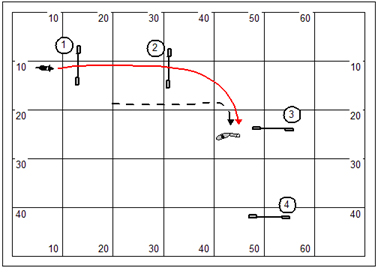I’ve given handling seminars for work in the TDAA for a number of years now. Part of my instruction has always been making the handler understand that he has to find a way to keep moving. The small courses sometimes present the illusion that the handler can assume a languid pace. And in some ways this might be true. But the key to work in the TDAA is finding a way to give sharpness and a sense of urgency when there is little real estate to work with.
Now in the TDAA we have more and more truly fast dogs entering the fray. For the most part handlers of fast dogs are unsuccessful at TDAA play because the transitional distances are so short that the simple physics of the dog’s movement make the riddle nearly impossible. And you know what people do when they can’t be successful… they quit.
My teaching these days must accommodate the handling requirements of the fast dog. Frankly what the handler must come to understand is that in the tight technical sequences they need to learn to gear their dogs down. Big long-legged fast dog handlers in venues like the USDAA have mastered the skill to gear their dogs down for technical work. But this sort of thing mightn’t ever occur to handlers jumping 16” or less… it isn’t necessary on courses with 20′ or 22′ feet between obstacles. These can be run full bore by the small dog.
It was our objective with the TDAA all along to give the small dog handler a taste of what the big dog handlers feel every weekend in competition. Be careful what you wish for. You just might get it.
The Moving Precue

Try to understand what the word “precue” means. The handler cues the dog to his intention to turn before the dog jumps (or dismounts any obstacle). To give the cue after the dog jumps means that you didn’t give a precue at all; all of the physics of the dog’s movement area already in place. If and when the dog follows the cue he’ll have to grind against the inertia of his movement to abide the handler’s instruction.
In this simple sequence the handler has two specific opportunities to give a precue, the first in the turn from jump #2 to jump #3, and the second in the turn from jump #6 to jump #7.
What I’ve tried to do in this illustration is demonstrate both position and timing of the precue (position and timing are nearly synonymous… but that is meat for another discussion).
While the dog is not even halfway from jump #1 to jump #2 the handler needs to turn and face back into the dog opening up his lead hand change while facing that hand back toward the dog. The best analogy I can make here is that it’s rather like a baseball catcher holding his glove right over the plate showing the pitcher the strike zone.
I’ve also drawn the dog’s ostensible path from jump #2 to jump #3. Note that the handler is positioned beyond that line ready to sweep the dog right across his toes in a nice straight line to the next jump. If the handler is on the wrong side of that line, then the dog’s path will have to be wobbly (or serpentine).
Please note that in the mechanics of the movement the handler will wait to see the dog up in the air over the jump, holding up the “glove” facing back into the dog. From the moment the dog hits the top of his jump arc the handler’s lead will swoop along the dog’s forward path to demonstrate the new direction of the course.
Caveat and Caution
I’m fascinated by precue movements. One of the things to which I’m constantly attentive is whether or not the dog actually takes the precue. If the dog takes the precue that means he should come wrapping over the jump bar into the turn. If he doesn’t take the precue then his turn will go wide and wobbly with too much forward inertia (maybe even taking the wrong course jump ahead!)
I’ve heard considerable statements voodoo science about the precue Front Cross. Take it all with the simple caveat… if the dog is not taking the precue, then the handler must play around with the mechanics of the presentation until he can find something that the dog actually understands.
Tomorrow
Tomorrow I’ll continue the topic with a discussion on “Gearing Down”.
BLOG471
Questions comments & impassioned speeches to Bud Houston: BudHouston@hughes.net. And Check out my latest publication the Just For Fun Agility Notebook #30 available at www.dogagility.org/store.














